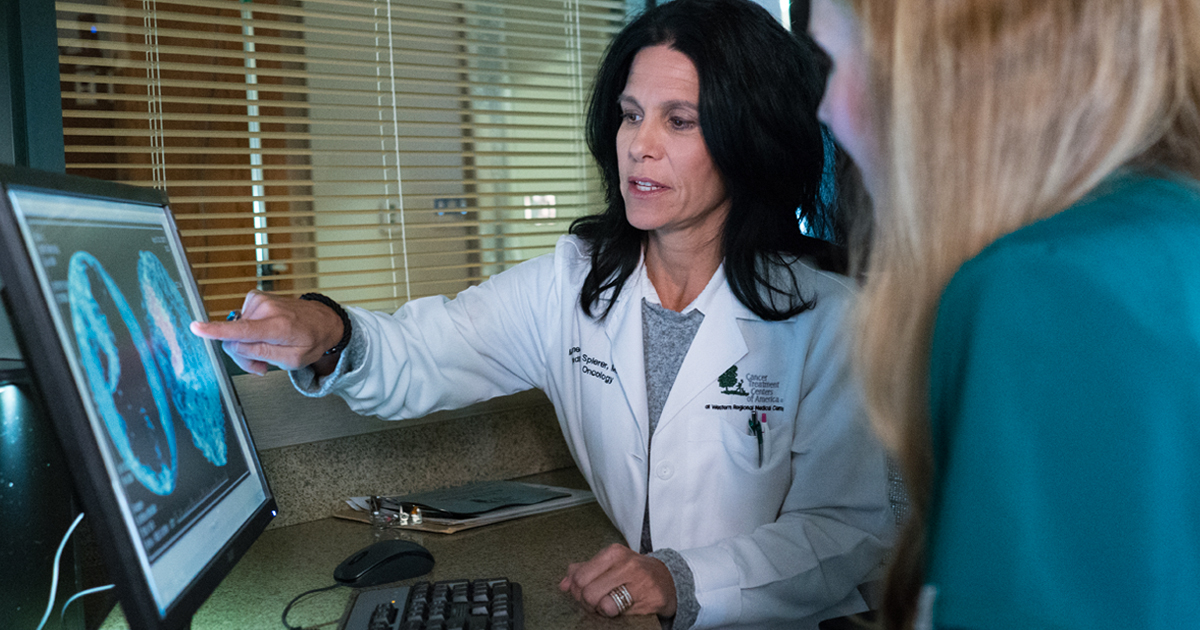
Cancer was once viewed as a disease that could only be treated through total destruction. Doctors—and patients—believed that the only way to kill cancer was to treat it swiftly and comprehensively, even if it meant negatively affecting the patient’s health in other, sometimes significant, ways. “Getting rid of the cancer was always our first priority, no matter the cost,” says Peter Baik, DO, FACOS, Thoracic Surgery Director at CTCA Lung Cancer Institute. “Anything that was cancerous, we wanted to attack, so we generally chose the most aggressive approach possible.”
In the past, that may have meant limb amputation, surgical castration or the complete removal of the chest muscle. But today, in this era of personalized, precision medicine, that one-size-fits-all approach has largely fallen out of favor. Instead, cancer treatment is often a matter of weighing options and determining what makes sense for each patient. In many cases, in fact, less is now more when it comes to cancer treatment.
“We used to tell patients, 'You have a liver metastasis, so you need part of your liver removed.' Now, we tell them, 'You have a liver metastasis, so here is your list of options.' We spend more time weighing the different options than just going ahead and treating, and most of those options spare much more normal tissue than treatments did in the past,” says Steven Standiford, MD, FACS, Surgical Oncologist at CTCA Philadelphia. After decades of research, scientists and oncologists have discovered that cancer is not just one disease but many, each with its own unique characteristics and tailored treatment options. One cancer may respond to a “nuclear” approach, for instance, but another may be treated over the course of a patient’s lifetime as a chronic but manageable illness. These learnings have helped lead to dramatic reductions in the severity and number of treatments patients receive.
They’ve also helped pave the way for more precision-focused treatments, such as targeted therapy, which are designed to pinpoint biomarkers unique to cancer cells, and immunotherapy drugs, which help the immune system recognize and attack cancer cells.
By better targeting the cancer, these treatments typically lead to fewer side effects than chemotherapy and other standard approaches because they do not kill healthy cells. “The issue with non-targeted therapies like chemotherapy is that they can hit anything in their wake,” says Marnee Spierer, MD, Chief of Staff and Chief of Radiation Oncology at CTCA Phoenix. “We are learning that we can be more focused in our treatment and more direct and, therefore, potentially treat patients in a shorter period of time, with fewer therapies and with potentially fewer side effects.”
The evolution of cancer treatment: From more to less
In 1882, William Halsted, Professor of Surgery at Johns Hopkins University, performed the first radical mastectomy, which became the standard of care for breast cancer surgery for almost a century. During a radical mastectomy, a surgeon removes the breast tissue along with the nipple, lymph nodes in the armpit, and chest wall muscles underneath the breast. But 100 years later, in the 1980s, clinical trials found that a lumpectomy was an equally viable option that was far less extensive and easier on the patient, since it removed the primary tumor, not the breast itself. “When I started practicing in the 1980s, mastectomies were still pretty much the standard, and we would talk about who was a potential candidate for a lumpectomy,” Dr. Standiford says. “Now, it’s completely the opposite. We talk about who is not a candidate for a lumpectomy. The entire perspective has changed.”
In June, the breast cancer treatment paradigm shifted again, when a landmark clinical trial found that two-thirds of women who have early-stage breast cancer and are treated with chemotherapy don’t necessarily need it. The results, published in the New England Journal of Medicine, concluded that most early-stage breast cancer patients with an intermediate risk of recurrence—around 85,000 women a year—may safely forego chemotherapy.
Prostate cancer treatment has undergone a similar evolution. For more than a century, the standard treatment called for removing the prostate during surgery. But research has shown that because prostate tumors grow so slowly, most men are more likely to die of something other than their cancer. So today, many men with early-stage prostate cancer may choose active surveillance over surgery, avoiding potential side effects like incontinence and sexual dysfunction.
Similarly, bladder cancer patients often have their bladder removed, forcing them to either wear a permanent bag to collect urine or undergo surgery to have a new bladder created from the intestines. Now, though, a clinical trial is underway, studying whether patients with certain types of bladder cancer may choose active surveillance over surgical removal of the bladder.
Research has also found that, in certain cases, patients with throat cancer caused by the human papillomavirus (HPV) may receive less invasive treatments than those whose cancer was not caused by HPV. And a study published in August in the New England Journal of Medicine found that many patients with advanced kidney cancer may be treated with chemotherapy alone rather than the standard surgery and chemotherapy combination commonly used to treat the disease today.
The “less is more” trend has also shifted many radiation therapy approaches. Studies are increasingly finding that fewer but stronger doses of radiation are just as effective as a larger number of doses given at lower concentrations in treating many cancer types. According to study results published in The ASCO Post in October 2017, for example, “a higher-dose, shorter form of radiation is safe, effective, and no more damaging to the breast tissue or skin of breast cancer patients under age 50 than it is in older patients.” Some men may also opt for significantly shortened radiation regimens for prostate cancer. “Prostate cancer patients with certain types of tumors who would have received dozens of radiation treatments in the past now may be eligible for as few as five treatments,” Dr. Spierer says. “This has become increasingly standard within the past few years.”
The quality-of-life factor
The emphasis on quality of life has played its own important role in scaling back aggressive treatments. “There was not nearly the emphasis on quality of life when I started practicing medicine as there is today,” Dr. Standiford says. “In the past, if someone was going to be getting four months of chemotherapy after his surgery, we would tell him he wasn’t going to be able to work for four months. Today, we tell him that if he gets his chemotherapy on Friday, he can be back at work on Monday. Patients nowadays want to be empowered to make their own decisions and get back to normal life as quickly as possible.”
The increased focus on patients’ well-being has also influenced doctors to take a broader view of the risks involved in treatment before making a recommendation. “We now weigh all the factors when treating cancer,” Dr. Standiford says. “Not just cancer risks, but health risks, in general.” For example, a woman treated with radiation for cancer in her left breast has a higher risk of heart attack than a woman who received radiation in her right breast—an important consideration for doctors today. Also, many surgical oncologists heavily weigh the impacts on a lung cancer patient before recommending surgery. “If I perform surgery on someone who will probably have to live with cancer for the rest of his life and, after the surgery, he has to receive supplemental oxygen every day, something he’s never had to do before, I may have treated the cancer, but did I really treat the patient?” Dr. Baik says.
In the same way, a non-small cell lung cancer patient may choose a wedge resection, or the surgical removal of cancerous cells in the lung, as an alternative to a lobectomy, in which up to 40 percent of the lung is removed, because it’s less invasive. But that shouldn’t be the only factor considered, Dr. Baik says. “The recurrence rate with a wedge resection can be high, so choosing the less invasive route isn’t always the right choice,” he says. “You have to be careful. Yes, we want less invasive, but we have to scrutinize the decision and make sure we’re not missing anything.”
The patient’s age and health are also important to consider when choosing cancer treatment options. If an early-stage lung cancer patient is 90 years old and unable to tolerate surgery, for example, radiation may be the preferred choice because it involves a more focused treatment with fewer impacts on healthy tissue. In fact, an August study published in the Journal of the American Medical Association found that for elderly women with breast cancer, surgery may not be the recommended option because it diminishes quality of life.
The “Angelina Jolie effect”
Still, the decision about which treatment to choose ultimately lies with the patient. “I tell some patients that radiation therapy will add very little benefit to their treatment,” Dr. Spierer says. “But some will choose to do it anyways. They want everything. But what they don’t understand is that ‘everything’ still doesn’t guarantee that they’ll be cured, and they’re still getting side effects from the treatment.”
Some doctors say young women are the ones who generally want more aggressive treatments, even when they’re not warranted. This tendency is commonly referred to as the “Angelina Jolie effect,” the term coined to describe the impact made when actress Angelina Jolie announced in a 2013 New York Times op-ed piece that she’d undergone a preventative double mastectomy after learning she was a BRCA1 gene mutation carrier.
“Young people are generally the ones who come in with early breast cancer but request a double mastectomy so they never have to worry about it again,” Dr. Standiford says. “It’s actually the older patients who are more likely to proceed with less treatment in cases when they can.” But patients who opt for more aggressive treatment, even when it’s not warranted, are often ignoring the fact that because they carry certain breast cancer gene mutations, they’re also at an increased risk for other cancers, including ovarian, pancreatic and colorectal. “Being more aggressive with one cancer doesn’t free you from cancer forever,” he says. “It’s not one-stop shopping. A cancer diagnosis is life-long.”
Choosing a potentially unnecessary treatment is often an individual decision, one that can vary dramatically from person to person. “I’ve learned that everyone has a different gray area,” Dr. Standiford says. “There are people who say they still want chemotherapy, even when a doctor tells them it would only give them a 2 percent benefit. But there are also people who turn down chemotherapy if it would give them a 20 percent benefit. Twenty percent isn’t a big enough number for those people. Today, it’s not just that we’re able to determine who doesn’t need chemotherapy. It’s letting people make an informed choice whether they want chemotherapy.”
Less doesn’t mean inferior
In the future, doctors hope researchers will continue to discover biomarkers that will help predict how a certain tumor will respond to treatment so more targeted therapies may be developed. “It’s an interesting, exhausting and exhilarating time to be a doctor,” Dr. Standiford says. “I’ve been practicing for 30 years, and when I was in medical school, we were just learning about T cells and B cells. That was all we knew about the immune system. There are so many sophisticated things researchers are learning now that we never could have imagined.”
Much of what scientists are learning today is made possible by the significant advances that technology has made in recent years. “‘Less is more’ is the theme today because we know more,” Dr. Baik says. “We’ve seen so much more data in the past 20 to 30 years. Prior to that, much of what doctors did wasn’t really evidence-based. We were still recording everything on paper. Now there is much more evidence, and more studies and research being done. Now we’re having tens of thousands of patients studied and looking at the outcome. We’re more aware of what the outcomes are going to be for certain types and stages of cancer.”
Yet the most important takeaway may be that less treatment doesn’t mean inferior treatment. “‘Less’ means using scientific evidence to show that we don’t have to do certain things,” Dr. Baik says. “We may be able to treat you with less and still achieve the same results.”



